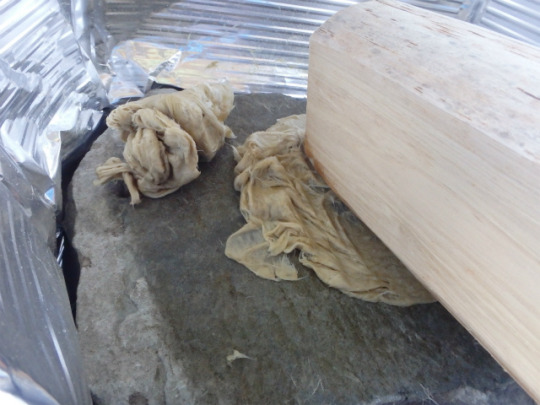
和紙の原料であるコウゾを収穫して蒸して皮を剥いてへぐって煮てチリを取ったものをたたいています。
この作業では 繊維の開き具合などを調節できます。
少し長めの繊維も残しつつかといって出来た紙の面を荒立てる様にならない程度をねらいます。
それは、絵をつけた時 細かい細工まで鮮明に見れるように面のきめを整えたいからです(これは紙にして乾かす時にも工夫があるのですが)
そして その後の水洗いで紙(繊維の絡んだシート)の繊維が抜けにくい様に長くしっかり残したいのです。
でないと、せっかく絵をつけても全てが出来上がるまでの工程で紙が破れてしまうこともあるからです。
あらゆる作業の中にねらいがあり、試行錯誤があり、想像力との答え合わせの、楽しみがあります。
I am beating cooked barks of Kozo (papermulberry), the raw material of washi (Japanese handmade paper), following the process of harvesting, steaming and unbarking the stalks of Kozo, and scraping the upper most layer of the stripped barks.
In this process, I can adjust how separated the fibers will be.
I intentionally leave a certain amount of rather long fibers, which is just enough to make sure that the surface of the made papers is not roughed by them.
This is because I would like to form the texture of the surface fine, so that one can see every single detailed work when I eventually apply colors onto it. (For the same purpose, there are other things I do during the process of drying the papers I make.)
Another aim is to make the fibers stay firmly when I wash the paper (the sheet made with intertwimed fibers) with water after dyeing.
Otherwise, even after I applied colors, during the process of finishing the papers may tear without seeing the completion.
In every single work I do, there are intentions, trials and errors, and the joy to discover the answers to my imagination.
